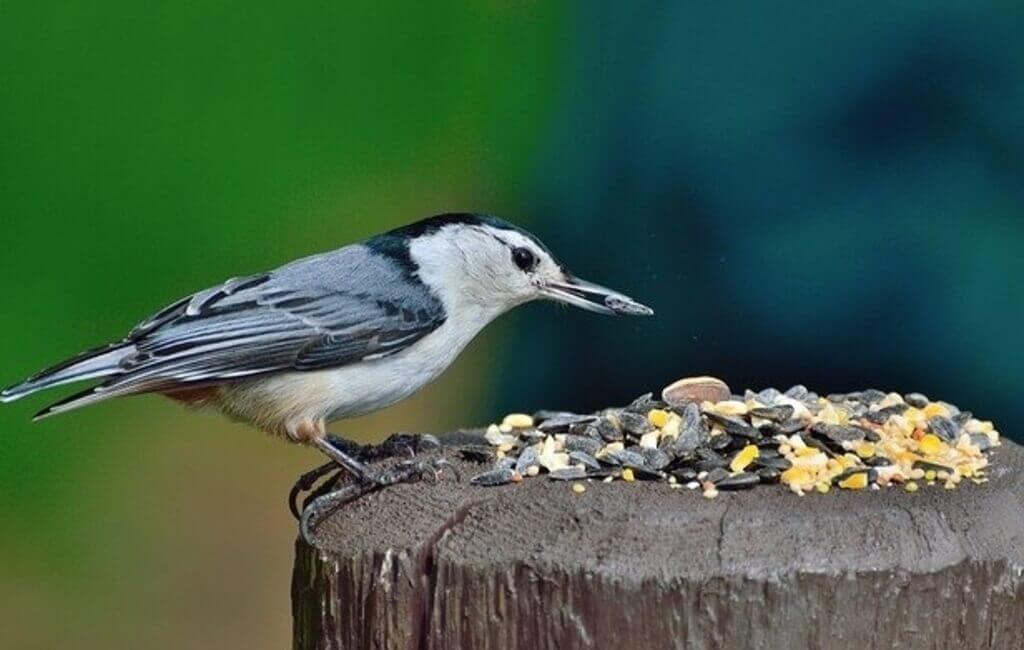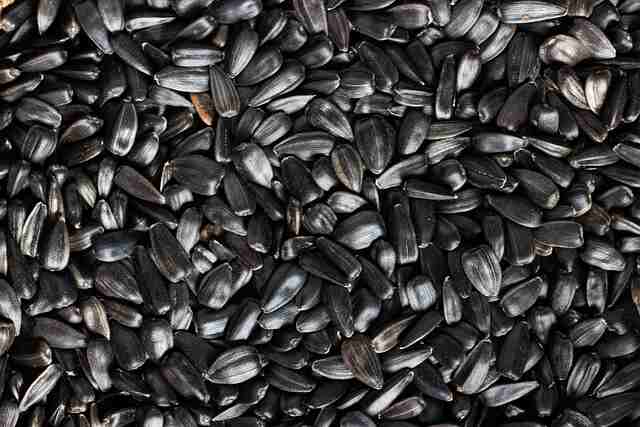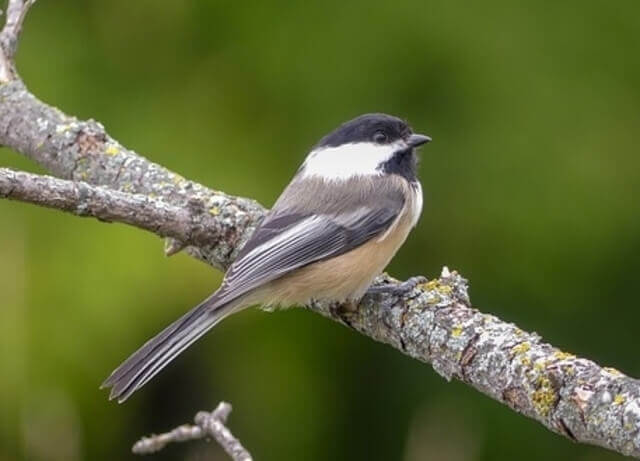Sunflower seeds are a beloved snack for many bird species, offering both nutrition and energy. In this guide, we’ll highlight 22 birds that are particularly fond of sunflower seeds, giving you insights into their feeding habits and preferences. Let’s dive into the world of sunflower seed-loving birds and enhance your bird watching experience!
Table of Contents
- 1 Types of Sunflower Seeds for Birds
- 2 Nutritional Benefits of Sunflower Seeds
- 3 How to Feed Sunflower Seeds
- 4 Birds That Eat Sunflower Seeds
- 4.1 Common Grackle
- 4.2 Common Blackbird
- 4.3 European Starling
- 4.4 Carolina Wren
- 4.5 Pine Siskin
- 4.6 Steller’s Jay
- 4.7 Brown Thrasher
- 4.8 House Finch
- 4.9 Purple Finch
- 4.10 American Goldfinch
- 4.11 House Sparrow
- 4.12 White-breasted Nuthatch
- 4.13 Black-capped Chickadee
- 4.14 Evening Grosbeak
- 4.15 Northern Cardinal
- 4.16 Blue Jay
- 4.17 Downy Woodpecker
- 4.18 Hairy Woodpecker
- 4.19 Red-bellied Woodpecker
- 4.20 Tufted Titmouse
- 4.21 Eastern Towhee
- 4.22 Mourning Dove
- 5 Author
Types of Sunflower Seeds for Birds
Black-oil Sunflower Seeds
Black-oil sunflower seeds, treasured by bird enthusiasts, are a top bird-feeding choice due to their thin shells and high oil content. These seeds are easy to crack open, providing essential calories, especially in winter. They also support feather health and reduce feeder mess, attracting a diverse range of avian visitors.
As for which birds eat whole sunflower seeds, species such as cardinals, known for their strong beaks, and American goldfinches are regular consumers. Sparrows, jays, chickadees, nuthatches, and woodpeckers also enjoy whole sunflower seeds.
Striped Sunflower Seeds
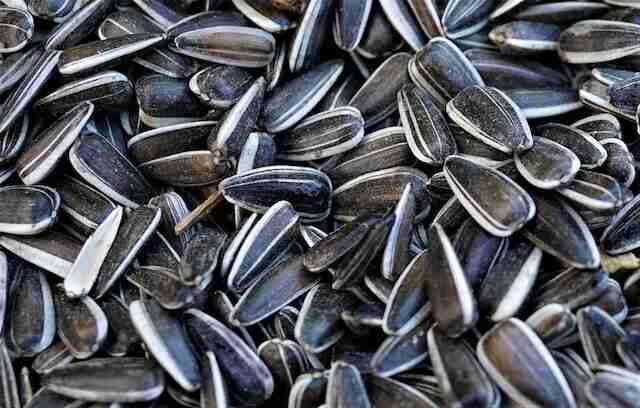
Striped sunflower seeds, a close relative of black-oil sunflower seeds, offer unique benefits for bird feeding. Their larger size and harder shells attract birds with stronger beaks like woodpeckers and jays. These seeds provide a rich source of energy, especially in colder seasons.
Birds that eat whole striped sunflower seeds include blue jays, northern cardinals, grosbeaks, and woodpeckers due to their robust beaks and size advantage for accessing the seeds’ contents.
Sunflower Hearts and Chips
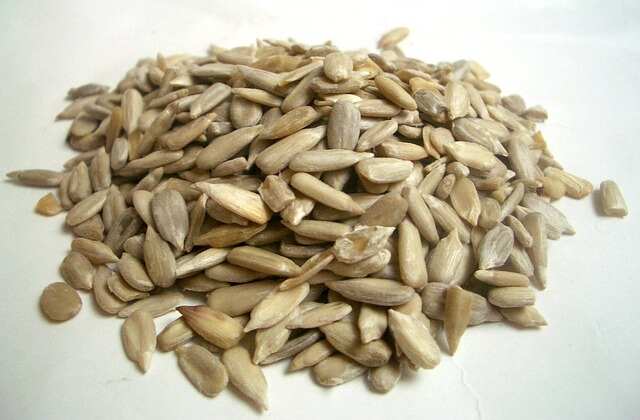
Sunflower hearts and chips are a favored choice for both birds and enthusiasts, offering high energy without the mess. They attract a variety of birds like finches, sparrows, chickadees, and more, making them perfect for diverse backyard birdwatching.
As for which birds eat sunflower hearts and chips, a wide range of species enjoys them, including finches, sparrows, chickadees, nuthatches, titmice, doves, cardinals, and grosbeaks. These seeds are versatile and appeal to various feathered visitors in your backyard.
Nutritional Benefits of Sunflower Seeds
| Nutrient | Benefits |
|---|---|
| Protein | Essential for muscle development and energy production |
| Healthy Fats | Help maintain body heat and insulation |
| Iron | Supports blood health and oxygen transport |
| Magnesium | Important for metabolic processes and muscle function |
| Potassium | Aids in maintaining proper fluid balance |
| Vitamins (A, B, C, D) | Contribute to overall health, immunity, and vitality |
Sunflower seeds are a convenient and energy-packed food source, playing a crucial role in sustaining avian populations year-round.
How to Feed Sunflower Seeds
- Select the Appropriate Feeder: Choose a suitable feeder type like tube, hopper, or tray feeders depending on the bird species you want to attract.
- Seed Choice: Use high-quality sunflower seeds, preferably hulled varieties like sunflower hearts and chips, to reduce mess and waste.
- Ideal Location: Place the feeder in a visible and safe spot, ensuring easy access for both birds and yourself.
- Regular Maintenance: Clean the feeder every two weeks or when soiled to prevent mold and bacteria growth.
- Consistent Supply: Keep the feeder well-stocked throughout the year, especially in the winter when birds rely on supplemental food.
- Observe Bird Behavior: Pay attention to the types of birds that visit and their preferences for sunflower seeds or other foods.
- Enjoy Birdwatching: Be patient and relish the joy of observing and caring for your visiting avian friends.
Birds That Eat Sunflower Seeds
Common Grackle
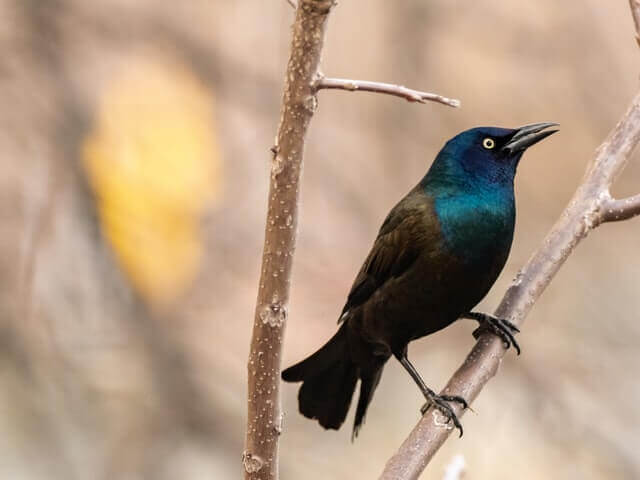
Do Common Grackles like to eat sunflower seeds? The answer is yes, and not just sunflower seeds. Grackles are scavengers that will consume anything from insects to rotting carcasses of other animals. They even raid beehives for honey and attack turkey nests for eggs! They do have a preference for grain-based foods like wheat, corn, oats, barley and rye; however they’ll also eat meat such as small mammals or baby birds caught in their environment.
- Length: 11.0-13.8 in (28-35 cm)
- Weight: 2.7-5.0 oz (75-143 g)
- Wingspan: 13.8-18.1 in (35-46 cm)
- Range: North America, Central America, South America, and into southern Canada.
- Habitat: Woodlands, grasslands, wetlands, forests, and even deserts.
- Diet: Insects like beetles and caterpillars but also fruits or berries.
Common Blackbird
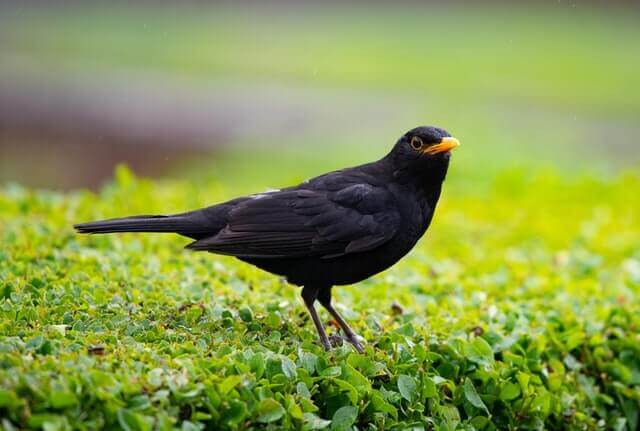
Blackbirds are common in North America. They can be found all over the country, and they eat lots of different things like seeds, insects, worms, berries and fruit. But one thing that blackbirds really love to eat is sunflower seeds! In fact, if you scatter a handful of sunflower seeds on the ground near your bird feeder, there’s a good chance that blackbirds will find them quickly. And once they do–watch out! Blackbirds will flock to those seeds and take as many as they can find.
- Length: 7.9-10.2 in (20-26 cm)
- Weight: 2.1-3.1 oz (59-87 g)
- Wingspan: 13.8-14.6 in (35-37 cm)
- Range: North America, Europe, and Asia.
- Habitat: Parks, on buildings, gardens, or even near farms.
- Diet: Insects, seeds, berries, fruit and worms.
European Starling
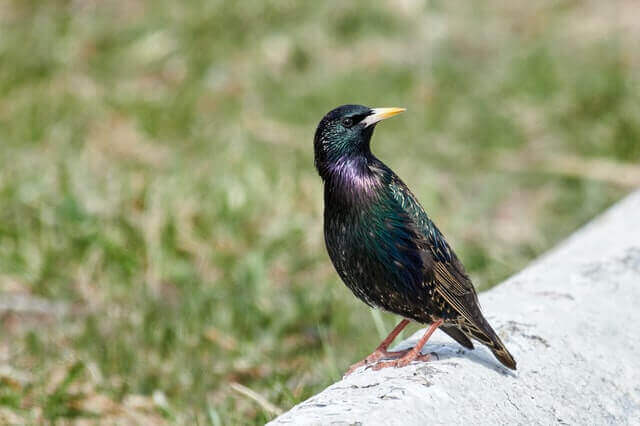
Sunflower seeds are a favorite food for many backyard birds. One such bird is the European Starling, which was originally from Europe and Asia. Starlings are omnivores, meaning they eat both meat and plants. They prefer to eat insects when they can find them, but will also go after corn and sunflower seeds if other food sources aren’t available.
- Length: 8.0-9.0 in (20.3-22.8 cm)
- Weight: 2.1-3.4 oz (59-97 g)
- Wingspan: 12.1-15.9 in (30.7-40.4 cm)
- Range: North America as well as Europe, Africa and Asia.
- Habitat: Urban areas, coastal marshes, farmlands, mountainsides, and forests.
- Diet: Seeds, fruits, insects, small animals like mice or voles, earthworms and snails.
Carolina Wren
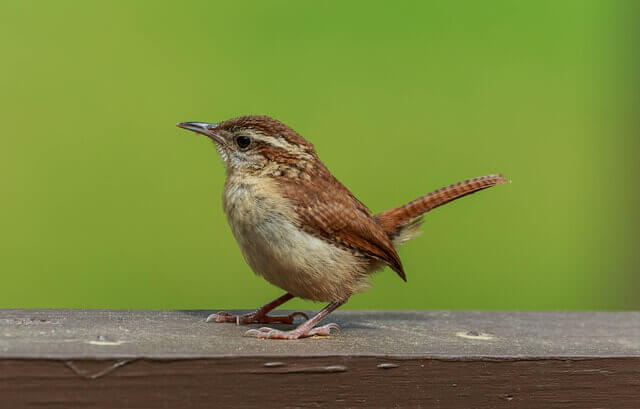
Carolina Wrens are one of the most common birds in North America. They feed on insects, seeds and berries. These birds have a particular taste for sunflower seeds, and will visit feeders that have them, so be sure to include them in your yard for the winter months when it’s too cold for them to find food. They also like to visit suet feeders with peanut butter or grape jelly mixed into the suet pellets.
- Length: 4.3-5.7 in (11-14.5 cm)
- Weight: 0.6-0.8 oz (17-23 g)
- Wingspan: 11.0-11.4 in (28-29 cm)
- Range: Eastern North America, South-eastern United States, Southern Canada, and Mexico.
- Habitat: Brushy areas like forests, thickets, hedges along field edges, shrubs, urban areas.
- Diet: Insects, spiders, berries and other fruit.
Pine Siskin
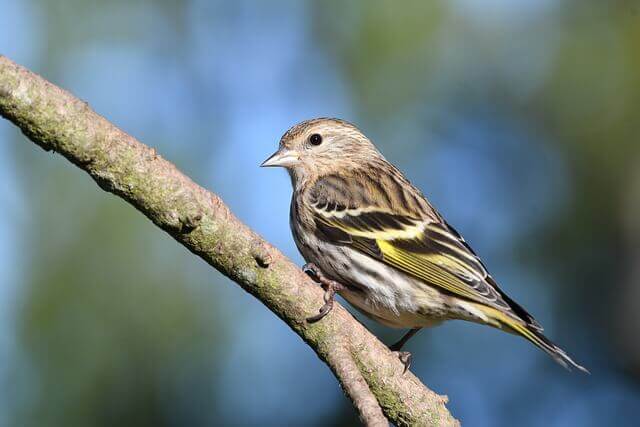
There are many things that you can do to attract Pine Siskin birds to your yard. One of the most popular is offering sunflower seeds in a feeder, but which months should you offer them? -In April and May, they will be hungry after their migration from South America. -From June through August, they will have more food available and less need for additional seeds. -The other good time is from September through November.
- Length: 4.9-5.7 in (10-14.5 cm)
- Weight: 0.4-0.7 oz (11-19 g)
- Wingspan: 6.7-9.0 in (17-23 cm)
- Range: Canada and most of the United States
- Habitat: Aspen forests, coniferous and deciduous woodlands, chaparral scrub lands, farmlands and parks.
- Diet: Insects, seeds and berries
Steller’s Jay
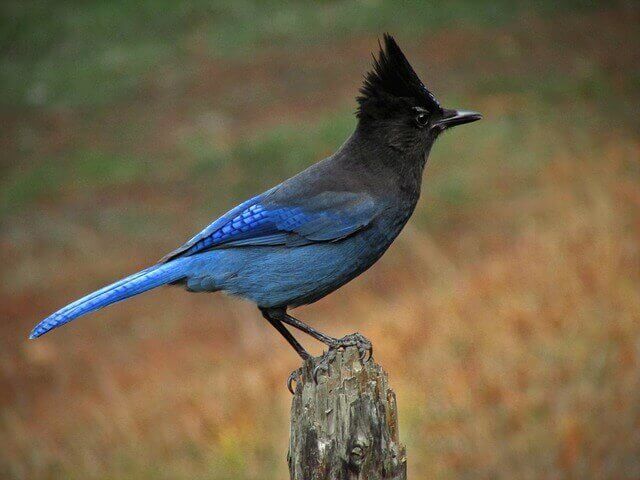
Steller’s Jays are a type of jay that is native to North America. These birds are found in woodlands, deserts, and mountain forests. They eat mostly seeds, berries, and insects. One way you can attract Steller’s Jays to your yard is by planting sunflowers in your garden, or bird feeders with this food item. To entice them, you will need to scatter these seeds around on the ground for the birds.
- Length: 11.8-13.8 in (30-35 cm)
- Weight: 3.5-5.0 oz (100-141 g)
- Wingspan: 17.0-17.4 in (43.2-44.2 cm)
- Range: Western part of Canada, United States, and Central America.
- Habitat: Forests, deserts, meadows, and agricultural areas.
- Diet: Mostly nuts and seeds but also insects such as grasshoppers or beetles.
Brown Thrasher
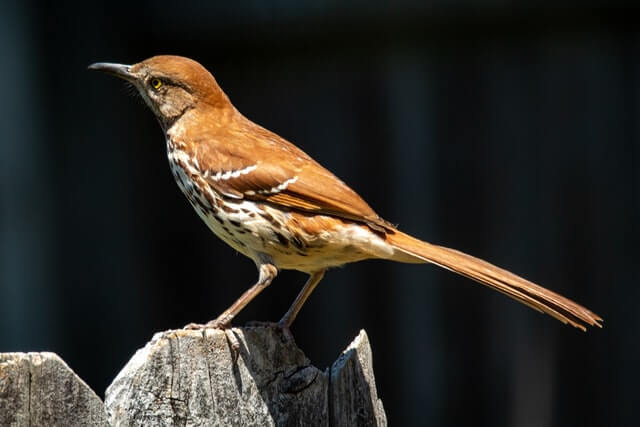
The Brown Thrasher is a common sight in most of North America. If you’re wondering how to attract Brown Thrashers, here are some ideas: – Place food in low areas near your home, such as under bird feeders or along the edges of gardens and lawns. -Get out your container of sunflower seeds and scatter them on the ground around where you see the Brown Thrashers congregating -Make sure there is plenty of food available by scattering more sunflower seeds on different spots around the area.
- Length: 8.8-11.8 in (22.5-30 cm)
- Weight: 2.1-3.1 oz (60-89 g)
- Wingspan: 11.4-12.8 in (29-32.5 cm)
- Range: North America, Central America, South America, and parts of Europe.
- Habitat: Deciduous forests, suburban areas.
- Diet: Insects, seeds, berries and fruit.
House Finch

House finches are one of the most common and well-known birds in North America. They can be found anywhere from backyards to farmlands, living in bushes or on power lines. House finches enjoy eating sunflower seeds, so by providing them with a supply of these little kernels you will attract these beautiful creatures into your yard and keep them coming back for more. In addition, they are packed with proteins and vitamins, making them healthy as well as tasty!
- Length: 5.0-5.9 in (12.7-15 cm)
- Weight: 0.5-0.99 oz (15-28 g)
- Wingspan: 8.1-9.8 in (20.5-25 cm)
- Range: Canada, United States, Mexico, Central America, South America, Cuba and Jamaica.
- Habitat: open fields, orchards, grasslands, hedgerows around pastures, wetland edges.
- Diet: Insects, fruits, seeds and nuts.
Purple Finch
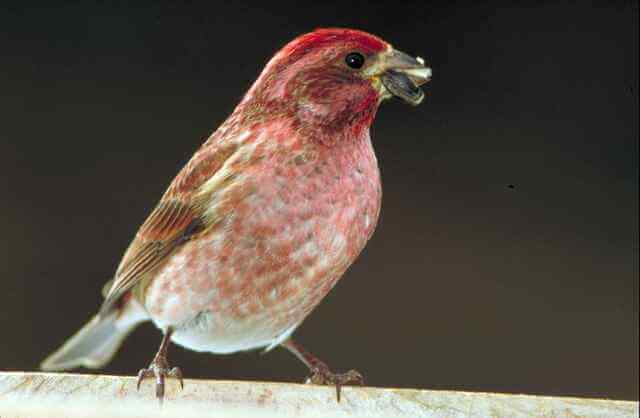
The Purple Finch is a small bird, and can be found in North America. These birds are mainly seed-eaters, but they also eat insects on occasion. The two main seeds that the Purple Finch eats are sunflower seeds and millet. It’s important to know when to feed these birds sunflower seeds because it provides them extra energy when migrating or when breeding.
- Length: 4.7-6.3 in (11-16 cm)
- Weight: 0.6-1.2 oz (18-33 g)
- Wingspan: 8.7-10.4 in (22-26.5 cm)
- Range: Alaska to southern Texas and northern Mexico, including the Rocky Mountains and as far north as Newfoundland.
- Habitat: Forests, orchards, parks and gardens, but they also will visit open areas such as fields.
- Diet: Seeds, fruit, insects, larvae, eggs and other small invertebrates.
American Goldfinch
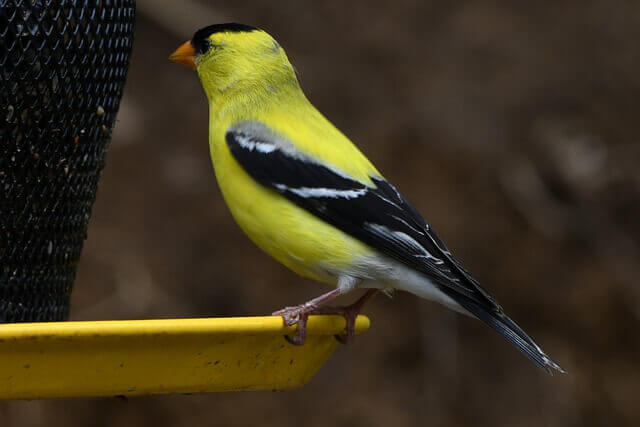
The American Goldfinch is a small, yellow and black birds that love to eat sunflower seeds. These birds most often found in the Eastern United States, but can also be found in some Western states as well. In fact, they are one of the most common visitors to bird feeders in North America. Goldfinches often visit bird feeders with their favorite foods, sunflower seeds and millet, which is high in protein and fat content.
- Length: 4.3-5.1 in (11-13 cm)
- Weight: 0.4-0.7 oz (11-20 g)
- Wingspan: 7.5-8.7 in (19-22 cm)
- Range: North America, Central America, the Caribbean, northern South America and southern Asia.
- Habitat: Grasslands, forest edges, wetlands, suburban yards.
- Diet: Weed seeds, insects and berries but will also eat sunflower seeds or other nuts.
House Sparrow
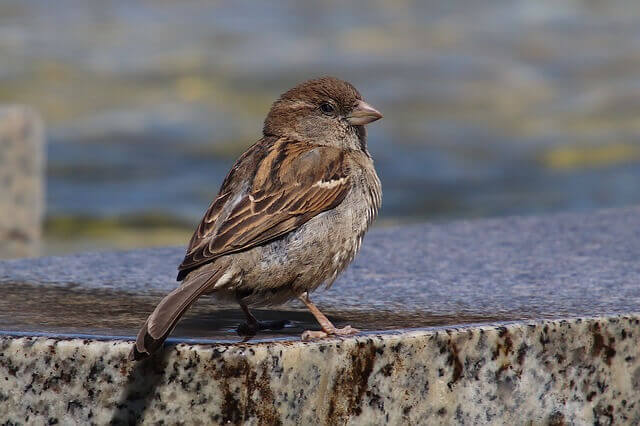
It is a well-known fact that House Sparrows will often frequent bird feeders if they are offered sunflower seeds. If you have been struggling to attract these birds, it may be time to switch up your tactics and try adding sunflower seeds. The more of these tasty treats that you offer, the more likely House Sparrows will be interested in stopping by for a visit. House sparrows will come to your yard as long as there is some food scattered on the ground.
- Length: 5.7-7.1 in (14.5-18 cm)
- Weight: 0.92-1.1 oz (26-31 g)
- Wingspan: 7.9-10.0 in (20-25.5 cm)
- Range: Europe, Asia, Africa, North America and South America.
- Habitat: Open areas such as fields and parks.
- Diet: Insects, seeds, and food scraps.
White-breasted Nuthatch
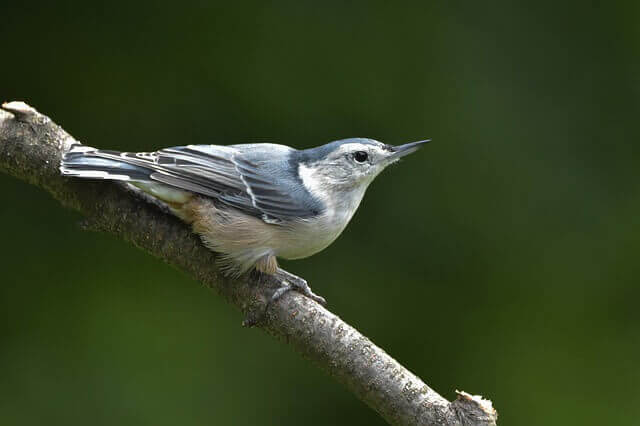
White-breasted Nuthatches are a small species of North American bird that feed primarily on seeds and nuts. They typically store their food in tree bark, crevices, or beneath the snow. If you’re looking for an easy way to attract White-breasted Nuthatches to your yard, consider placing sunflower seeds around your property. This will provide a high energy source for these birds as they prepare for winter.
- Length: 4.7-5.5 in (12-14 cm)
- Weight: 0.7-1.1 oz (19-31 g)
- Wingspan: 8.3-10.5 in (21-27 cm)
- Range: Canada to Mexico and the Eastern United States.
- Habitat: Coniferous forests, mixed woodlands, orchards, suburbs and parks.
- Diet: Primarily eats insects but will also eat seeds, nuts, berries and fruit.
Black-capped Chickadee
The Black-capped chickadee is found in the United States and Canada. These small birds can be seen eating at feeders, where they will readily take on any type of seed, especially sunflower seeds. They do not care about whether it is cracked or whole; they will still gobble it up if given the chance. The reason why they love sunflower seeds so much is because the high fat content provides enough energy for the chickadees to live on all winter long.
- Length: 4.3-5.9 in (11-15 cm)
- Weight: 0.3-0.5 oz (9-15 g)
- Wingspan: 5.9-8.7 in (15-22 cm)
- Range: Woodlands, shrublands, open country, farmland and suburban areas.
- Habitat: Southern Canada to Northern Mexico.
- Diet: Insects, seeds, nuts and berries during different seasons.
Evening Grosbeak
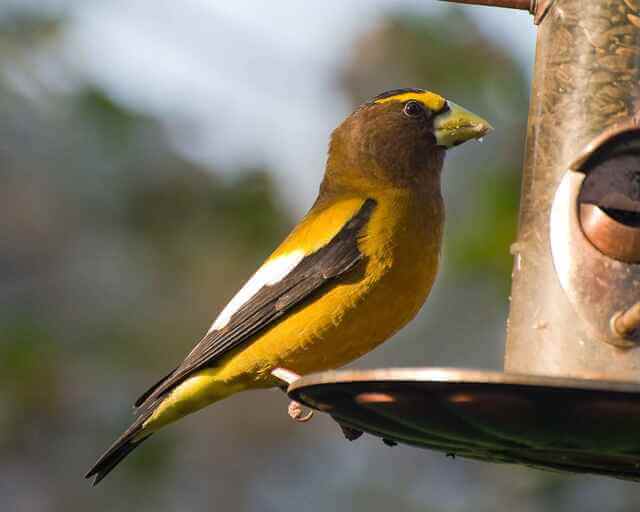
If you’re looking for a good way to Evening Grosbeaks to your backyard, there’s no better option than sunflower seeds. The seed-eating evening grosbeak species are drawn to sunflower seeds because they contain a high amount of fat and protein. Evening grosbeaks eat mostly sunflower seeds from July through September as they migrate south for the winter months.
- Length: 6.0-7.1 in (15-18 cm)
- Weight: 1.9-2.6 oz (53-75 g)
- Wingspan: 11.8-14.6 in (30-37 cm)
- Range: Southern Canada to the Gulf Coast and west into the Rocky Mountains.
- Habitat: Woodland edges, shrubby fields, suburban gardens and farmlands.
- Diet: Insects, seeds and berries.
Northern Cardinal

There are many people who enjoy feeding wild birds, and one of the best foods to offer them is sunflower seeds. One bird in particular that will come looking for the treat is the Northern Cardinal. Northern Cardinals are a very common sight in backyards and gardens all over North America. They love sunflower seeds! You can place them on your deck or balcony railing, or simply scatter them around your yard to provide entertainment for you and the bird life visiting your home.
- Length: 7.9-9.1 in (20-23 cm)
- Weight: 1.45-1.7 oz (41-48 g)
- Wingspan: 9.8-12.4 in (25-31.5 cm)
- Range: Eastern United States, Canada and Mexico.
- Habitat: Deciduous forests, coniferous forests, mixed woodlands, prairies, chaparral areas (shrubs), savannas (grassland with scattered trees), semi-deserts or deserts with scrubby vegetation and shrubs, and even sagebrush plains.
- Diet: Seeds, fruits, berries, insects and other small animals.
Blue Jay
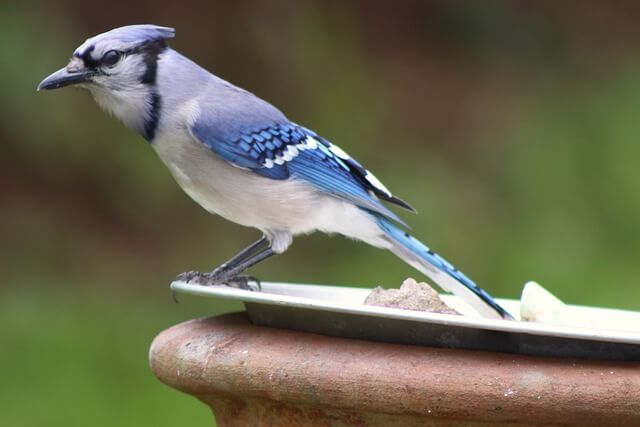
Sunflower seeds are a favorite of many backyard birds, including Blue Jays. In fact, blue jays will go to great lengths to get their hands on sunflower seeds, such as opening up feeders that have been filled with them. They will often steal all the sunflower seeds and leave nothing for other birds to enjoy. To make sure that the blue jays don’t eat all of your sunflower seeds, place some on the ground or in another area that is out of reach from these pesky birds.
- Length: 9.8-12.2 in (25-31 cm)
- Weight: 2.5-3.6 oz (70-101 g)
- Wingspan: 13.4-17.3 in (34-44 cm)
- Range: Eastern United States, Canada, Central America, and Northern South America.
- Habitat: Deciduous forests, coniferous forests, and residential areas.
- Diet: Seeds, fruits, insects, worms and snails.
Downy Woodpecker
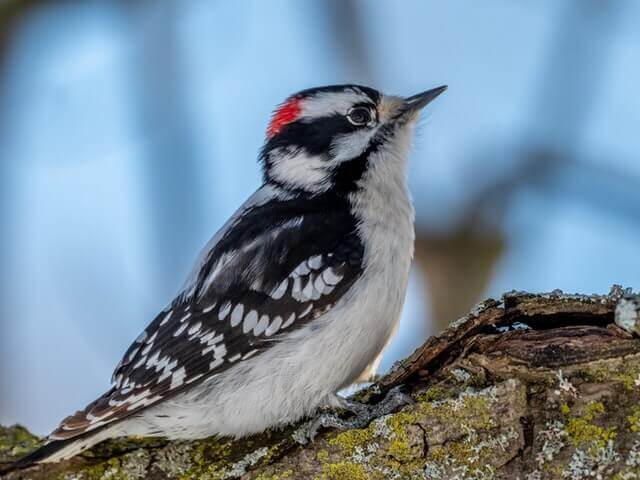
Woodpeckers are birds that live in trees. They have stiff tail feathers and a long tongue to help them get food out of holes in the tree bark. Downy woodpeckers are common North American species, living across most of Canada and all but the southwest US states. Downy woodpeckers have many favorite foods, including seeds from fruit, such as sunflower seeds. They also eat insects like ants or beetles, which they find on tree trunks and branches.
- Length: 5.5-7.1 in (14-18 cm)
- Weight: 0.71-1.0 oz (20-29 g)
- Wingspan: 9.5-12.2 in (24-31 cm)
- Range: Eastern United States, Canada and parts of Central America.
- Habitat: Forests, backyards, and parks with wooded areas as well as large cities.
- Diet: Mainly of insects, but also include nuts, seeds and berries.
Hairy Woodpecker
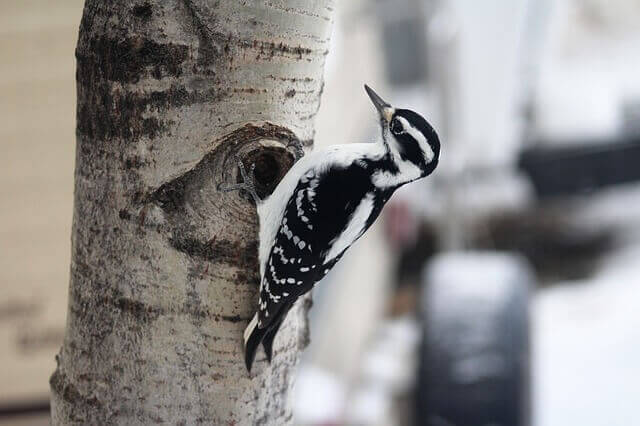
The Hairy woodpecker, or red-bellied woodpecker, is found in the eastern U.S. and southeastern Canada. These birds have a characteristic black and white striped pattern on their wings and tail feathers. Do hairy woodpeckers eat sunflower seeds? You bet they do! And you can often find them near bird feeders eating these delicious treats all winter long from November to March.
- Length: 6.7-10.6 in (17-27 cm)
- Weight: 1.4-3.4 oz (40-96 g)
- Wingspan: 12.6-16.5 in (32-42 cm)
- Range: Southeastern United States up into Canada
- Habitat: Forested areas, near rivers and streams, and around farmlands.
- Diet: Insects, nuts, berries and seeds.
Red-bellied Woodpecker
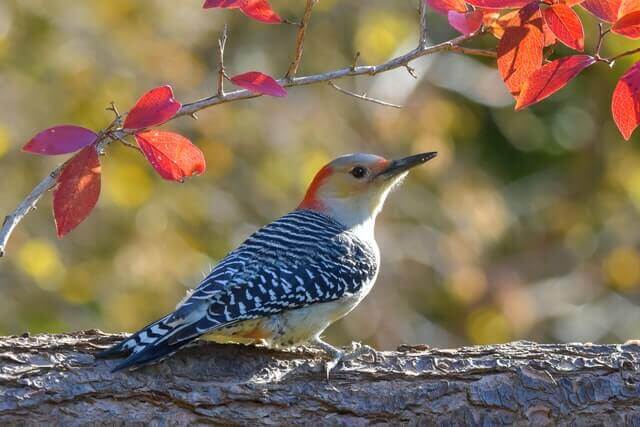
The Red-bellied Woodpecker is a type of woodpecker found in North America. This bird is mainly found throughout Southern Canada and the United States where they live in and feed on a variety of trees such as beeches, maple, oak and sumac. They eat mostly insects along with fruit when available, but will also visit feeders during the fall for a taste of some sunflower seeds.
- Length: 9.1-10.6 in (23-27 cm)
- Weight: 1.9-3.2 oz (55-91 g)
- Wingspan: 12.6-16.5 in (32-42 cm)
- Range: Southern Canada to Florida and as far west as Texas.
- Habitat: Deciduous forests as well as mixed forests with both hardwoods and conifers.
- Diet: Seeds, insects, spiders, fruits, berries and nectar.
Tufted Titmouse

The Tufted Titmouse is a small bird, and it’s one of the most common birds in North America. They’re very social animals, which is why they enjoy being near people. If you live in an area with many feeders, then you’ll likely see them often! Tufted Titmice are attracted to sunflower seeds from feeders because these small seeds provide lots of protein for their diet and are also high in fat content, which they need in the winter.
- Length: 5.4-6.4 in (13.7-16.3 cm)
- Weight: 0.6-0.9 oz (18-27 g)
- Wingspan: 7.9-10.6 in (20-27 cm)
- Range: Eastern half of North America, Mexico and Central America.
- Habitat: Forests, woodlands and suburban areas.
- Diet: Mainly of insects, nuts, seeds and berries.
Eastern Towhee

Eastern Towhees are a medium-sized, and is a large sparrow-like bird that is found in North America. They are very common and can be seen on lawns and farms all across the United States. Eastern Towhees usually feed on seeds from plants or the ground, but they will also eat sunflower seeds from feeders when given the opportunity.
- Length: 6.7-8.3 in (17-21 cm)
- Weight: 1.1-1.9 oz (31-53 g)
- Wingspan: 7.9-11.2 in (20-28.5 cm)
- Range: Eastern United States, Northeastern United States, and Southwestern Canada.
- Habitat: Fields, forest edges, open woodlands, and near streams.
- Diet: Mostly insects, seeds from weed plants, berries and small animals.
Mourning Dove
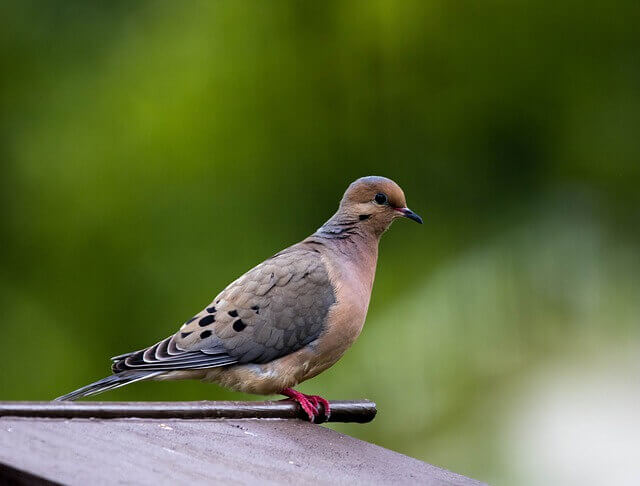
Mourning Doves are a delightfully unique and fascinating species of bird, that is a common sight in backyards across the country. Mourning doves eat sunflower seeds from feeders in their backyard. They have found this to be an excellent source of food for them, as they will gladly sit on the ground next to the feeder, eating until all the seeds are gone.
- Length: 8.3-13.8 in (21-35 cm)
- Weight: 3.3-6.0 oz (94-170 g)
- Wingspan: 16.1-17.7 in (41-45 cm)
- Range: North America, South America, Central America, and the Caribbean.
- Habitat: Forest edges, fields near woodlands, pastures near open areas.
- Diet: Insects, seeds, grains, fruits and berries

